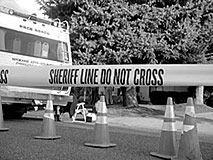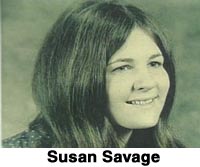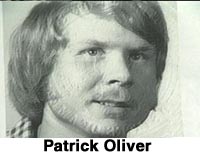

Robert Yates

At
6.30am on April 18, Robert Lee Yates Jr, 47, a married father of
five, was arrested for the murder of 16 year old Jennifer Joseph .
As
Yates sat at the police station more charges of murder were added to
the initial murder charge after a taskforce closed it trap around
Yates. A task force had been mobilized to track the serial killer.
Yates became a prime suspect when witnesses described seeing Yates'
1977 white corvette in the area on the nights that the women
disappeared. Last spring, Yates was questioned and detectives found
enough evidence from Jennifer Joseph in the car, which led to his
initial arrest.
Detectives begun round-the-clock surveillance of Yates for the two days preceeding his arrest. After he returned from a two-week Army National Guard camp where he has continued to his service as a helicopter pilot in the 66th Aviation Brigade of the Washington Army National Guard, which is headquartered at Gray Army Airfield, which is located on the base at Fort Lewis near Tacoma.
It
appears Spokane's Serial Killer grew bolder with each murder he
committed. At first he relied on time and distance to separate himself
from the crimes.
Later
on the gunman grew confident in his abilities dumping his victims were
they could be easily be found.
 In
the beginning, serial killer victims were turning up miles from where
they worked here along Sprague Avenue. Late in august of 1997, a
farmer found Jennifer Joseph's body underneath this pine tree in the
Mt. Spokane foothills. In
the beginning, serial killer victims were turning up miles from where
they worked here along Sprague Avenue. Late in august of 1997, a
farmer found Jennifer Joseph's body underneath this pine tree in the
Mt. Spokane foothills.
The
remote location is 12 miles from Sprague Avenue.
The
next known serial killer was Darla Scott. Her body was also discovered
in a rural area of the Hangman Valley. But in this case, the gunman
had cut the distance from Sprague Avenue in half.
The
killer's comfort zone would be cut in half again with the discovery of
Shawn McClenahan and Laurie Wason at 14th and Carnahan.
Their
bodies were found just three miles from Sprague Avenue's "Red
Light District".
More
than a half year later, in the serial killer's boldest execution,
Michelyn Derning died just a few blocks from where she entered the
serial killer's vehicle.
It
appears the gunman had become quite comfortable with
 attacking and disposing of his targets even in this very urbanized
area.
attacking and disposing of his targets even in this very urbanized
area.
Task
Force officials won't comment on concentric pattern of killings.
However
they do believe that as their investigation turned up the heat, Robert
Yates gave up his alleged campaign of murder.
The 47-year-old Spokane resident is currently employed as a replacement worker at Kaiser Mead, where he was hired in December 1998 as a strikebreaker after workers at the plant walked off the job.
Yates
would cruise a well known prostitution strip just a short drive from
his average suburban home from August 1997 to July 1998.
His main objective was to find prostitutes to murder. Most of the victims were white, with only one being asian, and they were all involved in prostitution or drugs or both. Yates' style was to shoot the victims in the head with a .25-caliber gun after covering their heads in several plastic grocery bags. Investigators suggest that the bags were a "signature" -- things serial killers do to their victims that are not necessary for murder. He would them dump the bodies where they would be found in remote locations but near well-traveled roads and in close proximity to each other. Almost all the victims had been killed elsewhere before being transported to "dump sites" where they were found. Semen was found on eight of the bodies. Three of the victims' bodies were within 50 yards of each other, and two of the bodies were touching. Three victims were found with vegetation from Yates' own home on top of their bodies, which also assisted in linking Yates to the crimes. On October 26, 2000 after many appalling plea bargains Yates was finally sentenced to 408 years in prison for 13 killings. Yates was then transferred to Pierce County where he is to face two further counts of first-degree murder of Melinda Mercer and Connie LaFontaine Ellis. At present he is pleading not guilty to the final two charges. The Murders  Susan
Savage, 22, and Patrick Oliver, 21 were the Susan
Savage, 22, and Patrick Oliver, 21 were the first to cross paths with the Robert Yates. In 1975 the young couple
were picnicking on Mill Creek, near Walla Walla, when Yates happened
upon them while practicing his target shooting in the same area.
first to cross paths with the Robert Yates. In 1975 the young couple
were picnicking on Mill Creek, near Walla Walla, when Yates happened
upon them while practicing his target shooting in the same area.
Patrick
Oliver was shot three times in the head before Yates turned on Susan
and shot her twice. Yates buried the couple's bodies under a pile of
brush where the were found within days. Yet it took a further 25 years
before the families of the couple would find out they were the first
victims of a serial killer, when Yates admitted he was responsible for
the murders.
 Twenty-three
year old Stacy Elizabeth Hawn from Seattle was the first prostitute
known to be killed by Yates around July 7, 1988. Her skeletal remains
were found five months later in Skagit County outside of Mount Vernon.
Stacy had been shot once in the head. Twenty-three
year old Stacy Elizabeth Hawn from Seattle was the first prostitute
known to be killed by Yates around July 7, 1988. Her skeletal remains
were found five months later in Skagit County outside of Mount Vernon.
Stacy had been shot once in the head.
Initially
Hawn was listed as a possible victim of the Green River Killer,
however Yates' finally admitted to her murder and was able to pinpoint
the location she was found as well as her injuries. His confession was
part of a plea bargain so he could avoid the death penalty.

Jennifer
Joseph, aged 16, was found on August 26, 1997. Her body was found in
an advanced state of decomposition in a small secluded spot at the
corner of Forker and Judkins Roads on the Peone Prairie. She had been
killed by a close-range gunshot to the chest. DNA was able to be
extracted from semen swabs and were undeniably matched to Yates. A
sleeve button found in the white Corvette formerly owned by Yates was
matched to the shirt worn by Joseph at the time of her death. The
analysis of blood smears found in the Corvette produced a match with a
DNA profile generated through samples from Joseph's parents.
 The
decomposed body of twenty-nine year old prostitute Darla Sue Scott,
was found on November 5, 1997 by a man walking his dog off Hangman
Valley Road. Two plastic bags that had been covering her head were
also found in her shallow grave. Her cause of death was two gunshots
to the head. DNA found on Darla's body was matched to Yates. The
decomposed body of twenty-nine year old prostitute Darla Sue Scott,
was found on November 5, 1997 by a man walking his dog off Hangman
Valley Road. Two plastic bags that had been covering her head were
also found in her shallow grave. Her cause of death was two gunshots
to the head. DNA found on Darla's body was matched to Yates.

On
December 7, 1997 the body of twenty-four year old Melinda L. Mercer,
24 was found on S. 50th St. in Tacoma. She had four plastic bags
covering her head and she had been shot three times.
 The
body of Shawn L. Johnson, aged 36, was found on December 18, 1997. Her
decomposing remains were found off Hangman Valley Road with two
plastic bags covering her head. The cause of death was two gunshots to
the head. Semen samples taken from her body were matched to Yates'
DNA. The
body of Shawn L. Johnson, aged 36, was found on December 18, 1997. Her
decomposing remains were found off Hangman Valley Road with two
plastic bags covering her head. The cause of death was two gunshots to
the head. Semen samples taken from her body were matched to Yates'
DNA.
Thirty
one year old Laurel Wason's body was found on December
 26, 1997, in a gravel pit near the Hangman Valley Road. Her head was
covered with three plastic bags cover her head and she had died from
two gunshot wounds to the head. Foreign vegetation, peanut shells,
packing Styrofoam and chips of broken concrete were found covering her
body that matched debris found in Yates' backyard. Semen found in her
body matched Yates.
26, 1997, in a gravel pit near the Hangman Valley Road. Her head was
covered with three plastic bags cover her head and she had died from
two gunshot wounds to the head. Foreign vegetation, peanut shells,
packing Styrofoam and chips of broken concrete were found covering her
body that matched debris found in Yates' backyard. Semen found in her
body matched Yates.
Shawn
A. McClenahan, 39 was also found December 26, 1997, next to the body
of Laurel Wason. Three plastic bags covered her head and the cause of
death was two gunshots to the head. DNA evidence from semen was
matched to Yates as well as a fingerprint on one of the plastic bags.
Foreign matter covering her body was also from Yates' backyard. Semen
found in her body was matched to Yates.
 Sunny
G. Oster, aged 41, was found on February 8, 1998. Her remains are
found in a wooded area in Western Spokane County and have all the
hallmarks of a Yates' murder. Her head is covered with three plastic
bags and she ahs two gunshot wounds to the skull. Yates' semen
was also found on her body. Sunny
G. Oster, aged 41, was found on February 8, 1998. Her remains are
found in a wooded area in Western Spokane County and have all the
hallmarks of a Yates' murder. Her head is covered with three plastic
bags and she ahs two gunshot wounds to the skull. Yates' semen
was also found on her body.

Thirty-four
year old Linda Maybin's decomposed body is found on April 1, 1998. Her
shallow grave is only 50 yards from the site of Wason and McClenahan's
gravesite.. Two plastic bags cover the victim's head. Cause of death
is one gunshot to the head. Semen in her body was matched to Yates'
DNA. Non-indigenous plant trimmings covering her body were matched to
vegetation in Yates' backyard.
 The
next victim was found on July 7, 1998. Forty seven year old prostitute
Michelyn Derning was found under a bath cover by a transient in an
area frequented by prostitutes in Spokane's East Central neighborhood.
Cause of death is gunshot wound to the head. Unlike all of the other
victims, she was seen alive a week before her body was discovered. The
others were found weeks, or sometimes months, after they disappeared.
Derning was not raped and was murdered where she was found. The
next victim was found on July 7, 1998. Forty seven year old prostitute
Michelyn Derning was found under a bath cover by a transient in an
area frequented by prostitutes in Spokane's East Central neighborhood.
Cause of death is gunshot wound to the head. Unlike all of the other
victims, she was seen alive a week before her body was discovered. The
others were found weeks, or sometimes months, after they disappeared.
Derning was not raped and was murdered where she was found.
 Connie
LaFontaine Ellis, 35, was found October 13, 1998, in a ditch near the
1700 block of 108th Street South in Tacoma. Her decomposed body has
three plastic bags covering her head and she had suffered only one
gunshot wound to the head. Connie
LaFontaine Ellis, 35, was found October 13, 1998, in a ditch near the
1700 block of 108th Street South in Tacoma. Her decomposed body has
three plastic bags covering her head and she had suffered only one
gunshot wound to the head.

Melody
Ann Murfin, 43, who disappeared in 1998 and was always regularly
included in the Spokane Serial Killer victim list. Her body was found
October 18, 2000, buried in the side yard under the bedroom window of
Yates' home. Although authorites thoroughly searched the yard after
his arrest, they found Murfin's body after Yates provided them with a
man pinpointing its location.
Christine
L. Smith, 32, was robbed and assaulted by a man in his van on August
1, 1998. Smith was grazed by the gunshot to her head but managed to
escape and report the attack to police.
Smith
had agreed to perform oral sex for $40 in the back of Yates' van in a
secluded parking lot in Spokane on Aug. 1, 1998. According to Smith,
Yates was driving a black van with a bed and mattress in the
back. Smith asked Yates if he was the "psycho killer."
that had been killing prostitutes at the time, Yates responded by
saying "he was not the killer because he had five kids and
would not do that."
After
several minutes when Smith had failed at arousing Yates with oral sex
Yates shot her in the head - (Smith had thought she had been hit
rather than shot), nearly causing her to lose consciousness however
Smith struggled to stay awake and keep her wits about her as she fell
backwards. Luckily the bullet had only scraped the side of her
face. Smith did not know she had been shot until a later x-ray showed
fragments in her face and skull.
She
contacted police again on April 18 after recognizing Yates as her
attacked from his mugshot published in The Spokesman-Review. Police
found blood stains, a .25-caliber bullet casing and a bullet encrusted
in the roof of a van similar to the one described by Smith that was
once owned by Yates. The fragments of bullet were later removed from
her head for ballistic comparison to other bullets from Yates'
victims.
THE
MAN
Robert
Lee Yates Jr. is an Army veteran who served nearly two decades as a
helicopter pilot for the U.S. Army. He is the married father of four
daughters and a son, ranging from age 11 to 25.
He
grew up in nearby Oak Harbor, Wash., a Puget Sound community where the
quiet calm is often punctuated by the rumbling of jet engines from
strike aircraft and patrol planes in the flight pattern at nearby
Whidbey Island Naval Air Station.
After
dropping out of college in the early 1970s, Yates married and enlisted
in the Army on Oct. 4, 1977. Within 3 years, Yates was a warrant
officer attending flight school at Fort Rucker, Ala., the home of Army
aviation. He graduated with a pair of flight wings authorizing him to
fly helicopters.
Yates
flew the OH-58 Kiowa, the military version of the Bell Jet Ranger
helicopter. Sleek, fast and highly maneuverable, the scout helicopter
served as a battlefield commander's eyes and ears.
Yates
was stationed overseas in Germany during the height of Cold War
tensions between Western Europe and the former Warsaw Pact. His
decorations included three Meritorious Service Medals, three Army
Commendation Medals, three Army Achievement Medals and a Humanitarian
Service Medal for participating in a relief mission to South Florida
to help clean up the devastation left by Hurricane Andrew in 1992.
He
also received two Armed Forces Expeditionary Medals one for each
tour he had spent flying in peacekeeping missions with the Unified
Task Force in Somalia in 1993 and in Haiti during Operation
"Uphold Democracy" in 1994.
"It's
real gutsy he would go out there and look for the enemy with no
weaponry," said Chief Warrant Officer-3 Jay Enders, who would
later fly with Yates in the Washington Army National Guard. "He
[Yates] was a true professional when he was out here, very
proficient."
Yates
ended his career as a chief warrant officer-4, the highest rank a
warrant officer could attain in the Army. He had amassed more than
5,000 hours of flight time in helicopters without a single mishap and
had been awarded the title of Master Army Aviator.
After
18 years as a career military aviator, Yates was almost within sight
of the coveted 20-year mark, when servicemen are eligible for
retirement benefits. Instead, Chief Warrant Officer Yates retired from
the Army in March 1996.
He
was a civilian again, finally settling with his family into a beige
two-story rancher on Spokane's South Hill. Within months of retiring,
however, Yates was looking to get back into the cockpit. In April
1997, the Washington Army National Guard granted his request.
But
Yates was unable to fly. A performance evaluation report filed by his
commanding officer in May 1998 noted that his "morale and
dedication remained high" despite not being able to fly "due
to delays in processing [his] medical examination."
While
Chief Warrant Officer Yates was grounded, detectives were working to
unravel the mystery behind a growing number of bodies that were being
discovered across Washington State.
|
Bibliography: News articles from time of the trial
Written by Korey Sifuentes
Copyright © 2002 by [The Crime Web].
Except
as provided by the Copyright Act 1968, no part of this publication may be
reproduced, stored in a retrieval system or transmitted in any form or by
any means without the prior permission of the author.
Original Written: January
30, 2002
Updated: January 30, 2002